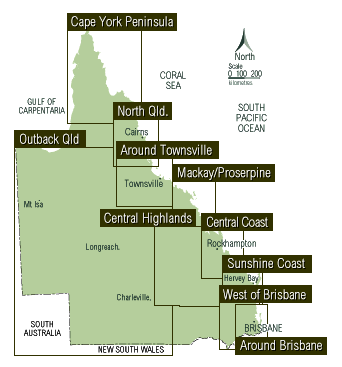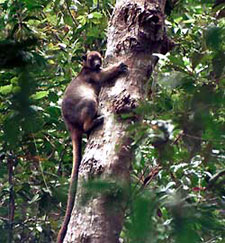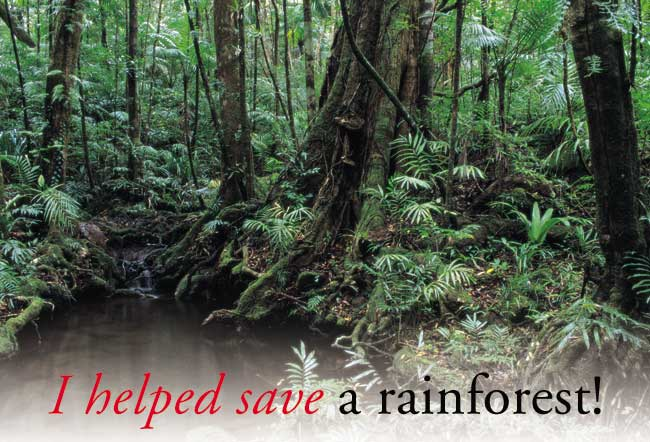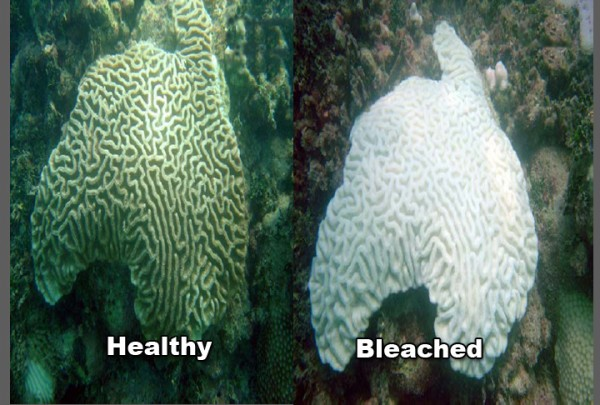
 et
Tropics Rainforests of North Queensland
et
Tropics Rainforests of North QueenslandW
 et
Tropics Rainforests of North Queensland
et
Tropics Rainforests of North Queensland
The
mountain rainforests of the Wet Tropics will decrease by 50% with
only 1°C of global warming (Hilbert et al. 2001).
North
Queensland’s World Heritage rainforests are home to 566 species
of vertebrate animals (28 percent of Australian vertebrates). The
entire region is likely to undergo ecological change as the climate
warms, but small temperature increases will threaten highland
rainforest environments on the top of mountains like Bartle Frere,
Bellenden Kerr and Thornton Peak. The effect of warming beyond 1°C
has not yet been studied, but there is potential for damage in other
areas of the rainforest as temperatures increase.
North Queensland’s World Heritage rainforests

Damage to the highland rainforests will impact on animals such as the Lemuroid Ringtail Possum Hemibelideus lemuroides, Herbert River Ringtail Possum Pseudochirulus herbertensis, Coppery Brushtail Possum Trichosurus vulpecula johnstoni and Lumholtz Tree Kangaroo Dendrolagus lumholtzi that depend on the trees for food. Rising carbon dioxide levels (triple pre-industrial levels) will affect leaf quality, with a decline in essential nitrogen of between 25 – 29 percent. The nitrogen content of the food trees affects the growth, survival and abundance of these mammal species, which is why higher numbers of these animals live in areas with high nitrogen soils.
The
abundance of the Lemuroid Ringtail Possum would decline by 30 –
40 percent if nitrogen content in highland trees falls by
15 – 20 percent. The other species are more sensitive to the
quality of leaves and may decline even further (Kanowski, 2001).
Any damage to the rainforests could have an impact on tourism. A study to assess the financial value of expenditure by tourists and recreational visitors to the World Heritage Area found that this was worth $377 million in 1991 – 92 (Driml, 1994).
A9c_s1_1

M ass
coral bleaching has occurred on several occasions in Australia’s
World Heritage listed Great Barrier Reef since the 1970s. A
particularly intense year of bleaching occurred in 1997-1998 caused
by human induced global warming, in association with a major El Nino
event and record high sea surface temperatures (Pittock
and Wratt 2001).
ass
coral bleaching has occurred on several occasions in Australia’s
World Heritage listed Great Barrier Reef since the 1970s. A
particularly intense year of bleaching occurred in 1997-1998 caused
by human induced global warming, in association with a major El Nino
event and record high sea surface temperatures (Pittock
and Wratt 2001).
The Great Barrier Reef is struggling to cope with sea temperatures that have been increasing steadily since early this century (Pittock and Wratt 2001). Tropical sea temperature has increased by almost 1oC over the past 100 years and is continuing to increase at the rate of 1 - 2oC per century (Hoegh-Guldberg, 1999).
Water only a degree or two warmer than usual can damage the symbiotic algae living in corals (zooxanthellae), causing these important organisms to leave the coral host. Without zooxanthellae to enable photosynthesis, corals usually die immediately following coral bleaching events (Hoegh-Guldberg 1999). While coral reefs can recover from bleaching, it is extremely unlikely if bleaching conditions continue year after year.
The Great Barrier Reef, the world’s largest continuous coral reef, could face severe bleaching events every year by the year 2030. The reef south of Cooktown is likely to be severely affected by sea temperature rise within the next 20-40 years (Hoegh-Guldberg, 1999).
M ass
bleaching, leading to death of corals, will become a more frequent
event on Australian coral reefs in the coming decades.
ass
bleaching, leading to death of corals, will become a more frequent
event on Australian coral reefs in the coming decades.
Tourism on the Great Barrier Reef had a financial value of
$682 million in 1991-92. Other uses include commercial fishing,
private boating and research and the total value of all uses is
estimated at close to $1 billion per year directly spent and earned
in the GBR World Heritage Area and adjacent mainland regions
Changes in the populations of marine organisms, too, could wreak havoc. Ciguatera poison, for example, is made by a micro-organism that attaches itself to algae growing in the warm waters of coral reefs. Small fish eat the algae, and are in turn eaten by larger fish like coral trout, Spanish mackerel, and red emperor, all of which accumulate the toxin.
While the fish themselves are unharmed, when eaten by people, the toxin can have debilitating effects. As global warming bumps up the ocean temperature, the ciguatera bug will be able to live further south and become more common in its current range.
A9c_s1_2